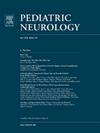Pediatric Immune-Mediated Necrotizing Myopathy: A Single-Center Retrospective Cohort Study
IF 3.2
3区 医学
Q2 CLINICAL NEUROLOGY
引用次数: 0
Abstract
Background
Immune-mediated necrotizing myopathy (IMNM) is a type of idiopathic inflammatory myopathies (IIMs), and the data concerning the phenotypes of pediatric IMNM are very limited. The present study aimed to elucidate the characteristics of pediatric IMNM.
Methods
We examined 116 pediatric patients with IIMs through a muscle biopsy-oriented registration study. Anti-signal recognition particle (anti-SRP) and anti-3-hydroxy-3-methylglutaryl-CoA reductase (anti-HMGCR) antibodies were detected via an immunoblot assay. A retrospective clinical, imaging, and myopathological analysis of 55 pediatric patients with IMNM was conducted.
Results
The cohort included 38 girls and 17 boys with a median age of 7 years. Acute/subacute onset occurred in 40.0% and chronic onset in 60.0% of the patients. Proximal and neck weakness were common symptoms. The frequencies of anti-HMGCR, anti-SRP, and seronegative myopathies were 61.8%, 20.0%, and 18.2%, respectively. Chronic onset was more common in anti-HMGCR myopathy than in anti-SRP myopathy (P = 0.003). Thigh magnetic resonance imaging revealed generalized muscle edema, and the severity of fatty infiltration correlated with disease duration. Necrotizing myopathy was most common among patients with seronegative IMNM, followed by patients with anti-HMGCR and anti-SRP myopathies. Dystrophic pathology was most common among patients with anti-SRP myopathy, followed by patients with anti-HMGCR myopathy and seronegative IMNM. After steroids combined with multiple immunosuppressant therapies, 18 of 39 (46.2%) patients achieved complete or partial remission. The percent of complete remission was significantly lower in patients with anti-HMGCR myopathy compared with those with seronegative or anti-HMGCR myopathies (P = 0.030).
Conclusions
IMNM is common in Chinese pediatric patients with IIMs. Most patients have anti-HMGCR antibodies, are more commonly female, have chronic onset and proximal weakness, lack other organ manifestations, have disease course-related muscle fatty infiltration, and have a poor response to immunosuppression.
儿童免疫介导的坏死性肌病:单中心回顾性队列研究
免疫介导的坏死性肌病(IMNM)是一种特发性炎症性肌病(IIMs),有关儿童IMNM表型的数据非常有限。本研究旨在阐明小儿IMNM的特点。方法:我们通过一项肌肉活检为导向的登记研究,对116例IIMs患儿进行了检查。免疫印迹法检测抗信号识别颗粒(anti-SRP)和抗3-羟基-3-甲基戊二酰辅酶a还原酶(anti-HMGCR)抗体。对55例小儿IMNM患者进行回顾性临床、影像学和肌病理性分析。结果该队列包括38名女孩和17名男孩,中位年龄为7岁。急性/亚急性起病占40.0%,慢性起病占60.0%。近端和颈部无力是常见症状。抗hmgcr、抗srp和血清阴性肌病发生率分别为61.8%、20.0%和18.2%。慢性起病在抗hmgcr肌病中比在抗srp肌病中更常见(P = 0.003)。大腿磁共振成像显示全身性肌肉水肿,脂肪浸润的严重程度与病程相关。坏死性肌病在血清阴性的IMNM患者中最常见,其次是抗hmgcr和抗srp肌病患者。营养不良病理在抗srp肌病患者中最常见,其次是抗hmgcr肌病和血清阴性IMNM。在类固醇联合多种免疫抑制剂治疗后,39例患者中有18例(46.2%)达到完全或部分缓解。与血清阴性或抗hmgcr肌病患者相比,抗hmgcr肌病患者的完全缓解率显著降低(P = 0.030)。结论simnm在我国儿童iim患者中较为常见。大多数患者有抗hmgcr抗体,多为女性,发病时间较长,近端无力,缺乏其他器官表现,有病程相关的肌肉脂肪浸润,对免疫抑制反应较差。
本文章由计算机程序翻译,如有差异,请以英文原文为准。
求助全文
约1分钟内获得全文
求助全文
来源期刊

Pediatric neurology
医学-临床神经学
CiteScore
4.80
自引率
2.60%
发文量
176
审稿时长
78 days
期刊介绍:
Pediatric Neurology publishes timely peer-reviewed clinical and research articles covering all aspects of the developing nervous system.
Pediatric Neurology features up-to-the-minute publication of the latest advances in the diagnosis, management, and treatment of pediatric neurologic disorders. The journal''s editor, E. Steve Roach, in conjunction with the team of Associate Editors, heads an internationally recognized editorial board, ensuring the most authoritative and extensive coverage of the field. Among the topics covered are: epilepsy, mitochondrial diseases, congenital malformations, chromosomopathies, peripheral neuropathies, perinatal and childhood stroke, cerebral palsy, as well as other diseases affecting the developing nervous system.
 求助内容:
求助内容: 应助结果提醒方式:
应助结果提醒方式:


